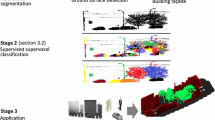Abstract
We present a framework to segment cultural and natural features, given 3D aerial scans of a large urban area, and (optionally) registered ground level scans of the same area. This system provides a primary step to achieve the ultimate goal of detecting every object from a large number of varied categories, from antenna to power plants. Our framework first identifies local patches of the ground surface and roofs of buildings. This is accomplished by tensor voting that infers surface orientation from neighboring regions as well as local 3D points. We then group adjacent planar surfaces with consistent pose to find surface segments and classify them as either the terrain or roofs of buildings. The same approach is also applied to delineate vertical faces of buildings, as well as free-standing vertical structures such as fences. The inferred large structures are then used as geometric context to segment linear structures, such as power lines, and structures attached to walls and roofs from remaining unclassified 3D points in the scene. We demonstrate our system on real LIDAR datasets acquired from typical urban regions with areas of a few square kilometers each, and provide a quantitative analysis of performance using externally provided ground truth.
Similar content being viewed by others
References
Anguelov, D., Taskar, B., Chatalbashev, V., Koller, D., Gupta, D., Heitz, G., Ng, A.: Discriminative learning of markov random fields for segmentation of 3D scan data. In: Proceedings of IEEE CVPR, pp. 169–176 (2005)
Nardinocchi, C., Scaioni, M., Forlani, G.: Building extraction from LIDAR data. In: IEEE/ISPRS Joint Workshop on Remote Sensing and Data Fusion over Urban Areas, pp. 79–84 (2001)
Funkhouser T., Kazhdan M., Min P., Shilane P.: Shape-based retrieval and analysis of 3D models. CACM 48(6), 58–64 (2005)
Golovinskiy, A., Kim, V.G., Funkhouser, T.: Shape-based recognition of 3D point clouds in urban environments. In: ICCV (2009)
Jiang, J., Zhang, Z., Ming, Y.: Data segmentation for geometric feature extraction from LIDAR point clouds. In: Proceedings of IEEE International Geoscience and Remote Sensing symposium, pp. 3277–3280 (2005)
Johnson A.E., Hebert M.: Using spin images for efficient object recognition in cluttered 3D scenes. IEEE TPAMI 21(5), 433–449 (1999)
Lalonde J.F., Vandapel N., Huber D., Hebert M.: Natural terrain classification using three-dimensional ladar data for ground robot mobility. J. Field Robotics 23(10), 839–861 (2006)
Luo Y., Gavrilova M.L.: 3D building reconstruction from LIDAR data. Lect. Notes CS 3980, 431–439 (2006)
Matei, B.C., Sawhney, H.S., Samarasekera, S., Kim, J., Kumar, R.: Building segmentation for densely built urban regions using aerial LIDAR data. In: Proceedings of IEEE CVPR, pp. 1–8 (2008)
Medioni G., Lee M.S., Tang C.K.: A Computational Framework for Segmentation and Grouping. Elsevier Science Inc, New York (2000)
Munoz, D., Vandapel, N., Hebert, M.: Directional associative markov network for 3-D point cloud classification. In: Proceedings of 3DVT (2008)
Sithole G., Vosselman G.: Experimental comparison of filter algorithms for bare-earth extraction from airborne laser scanning point clouds. ISPRS J. Photogramm. Romote Sens. 59(1–2), 85–101 (2004)
Tang C.K., Medioni G.: Curvature-augmented tensor voting for shape inference from noisy 3D data. IEEE TPAMI 24(6), 858–864 (2002)
Verma, V., Jumar, R., Hsu, S.: 3D building detection and modeling from aerial LIDAR data. In: Proceedings of IEEE CVPR, pp. 2213–2220 (2006)
You S., Hu J., Neumann U., Fox P.: Urban site modeling from LIDAR. Lect. Notes CS 2669, 579–588 (2003)
Zhang K., Yan J., Chen S.C.: Automatic construction of building footprints from airborne LIDAR data. IEEE Trans. Geosci. Remote Sens. 44(9), 2523–2533 (2006)
Author information
Authors and Affiliations
Corresponding author
Rights and permissions
About this article
Cite this article
Kim, E., Medioni, G. Urban scene understanding from aerial and ground LIDAR data. Machine Vision and Applications 22, 691–703 (2011). https://doi.org/10.1007/s00138-010-0279-7
Received:
Revised:
Accepted:
Published:
Issue Date:
DOI: https://doi.org/10.1007/s00138-010-0279-7




